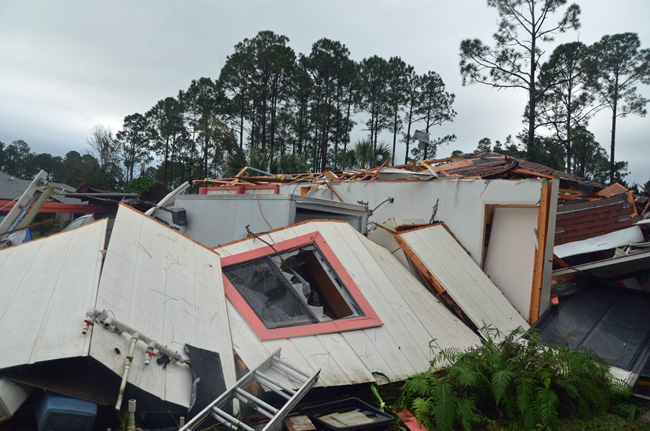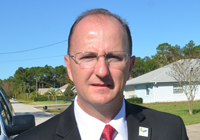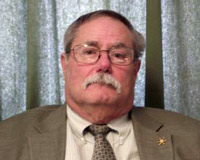
Palm Coast has a severe tornado-awareness problem.
Palm Coast residents were far less aware of the impending danger of a tornado in December than the residents of an Illinois County that was struck by a tornado in November, according to a new study comparing the two communities’ response to tornadoes, even though the same proportion of residents in both were enrolled in the immediate emergency notification system known as CodeRed.
In Palm Coast, 51 percent of those surveyed said they “knew there was a possibilities of tornadoes” on Dec. 14, when a tornado struck three neighborhoods, compared to “more than 89 percent of residents” who knew of such a possibility in Douglas County on Nov. 17, when a tornado struck there.
Startlingly, when Palm Coast residents heard of the tornado warning on Dec. 14, the majority—55 percent—took no action. In Illinois, 83 percent immediately went to a safe place. Not surprisingly, 85 percent of those surveyed in Illinois said they had adequate warning of the tornado in November, compared to just 66 percent saying so in Palm Coast. In both communities, 71 percent of respondents were enrolled in the live CodeRed system that alerts residents of emergencies.

“The fact that most residents didn’t take any action was the biggest concern,” Stephanie Meyers, the author of the study, said Thursday. “When I met with the city a little while ago and we went over these results, they asked me why and what do you think. I think a lot of it has to do with the fact that in Palm Coast tornadoes really aren’t a concern.” But that also underscores the complacency problem, and the challenge local emergency response faces in such emergencies, Meyers said.
Meyers, the marketing manager at Ormond Beach-based Emergency Communications Network, which runs the CodeRed system, conducted the study to shed light on those questions. Meyers was a graduate student at the University of Missouri’s School of Journalism and conducted the research project as part of her Master’s thesis. (She successfully defended the thesis in May.) On Thursday, Palm Coast released Meyers’s “Key Findings” in a brief report.
It was the first time that Kevin Guthrie, Flagler County’s emergency management director, had seen the survey results. He was skeptical about some of the numbers, noting disparities between the number of people who said they were “affected” by the tornado in palm Coast and the actual number of households that were: the study did not define what it meant to be affected.

“The numbers to me are a little questionable,” Guthrie said, referring specifically to the lack of clarity on who was warned and who wasn’t, since the CodeRed system targets participants very specifically. But that didn’t diminish Guthrie’s concerns. He continued: “I will say: do we have people that are complacent? Yes, we do, there’s no doubt about that, and it does concern me that if 51 percent who were notified, had knowledge that this thing was coming, 55 percent took no action. That is concerning. That is extremely concerning. I would have liked to see a follow-up question that’s says, knowing now what you know, that we did have a tornado, would you seek protection in the future.”
The results of the comparative survey contrast sharply with Palm Coast’s generally self-congratulatory response to the tornado. There was much to be proud of: The rapid reaction of first responders, including police, firefighters and paramedics ensured that the affected neighborhoods were quickly surveyed for damage and secured. That was followed by by the mayor’s emergency declaration and the city’s swift assistance to homeowners during clean-up. But the city has since maintained the focus on that aspect of its response, virtually romanticizing the event in a video narrated by the mayor and calling it the “Starlight Tornado,” after the name of the city’s annual Christmas parade. (See the video below.)
Beyond the awareness gap among the public, the study reveals a gap between local government’s ready response and the public’s willingness to respond to an emergency with equal urgency. Significantly, the response to the study by officials in Douglas County, who got the results six weeks ago, was immediate, urgent and broad. The response in Palm Coast, aside from a news release today, has been comparatively muted, though the city, too, got the results several weeks ago. Palm Coast’s release included a summary of the findings from the Palm Coast segment of the study and a list of tips on how to respond in an emergency.
Palm Coast Spokeswoman Cindi Lane said the city will conduct a social media campaign, update its website and continue to push CodeRed sign-ups, which have “increased dramatically” since the tornado. “Next year, when we update the disaster preparedness guide, we can review the findings to see what additional info we might provide,” Lane said. “And, of course, if there’s anything Emergency Services would recommend, I’m sure we would do that, too.”
Joe Victor, Douglas County’s Emergency Management Agency Director (who doubles up as the county coroner) said in an interview Thursday that the county immediately took the results of the survey very seriously when it received them because he saw troubling findings—even though the study showed Douglas County’s awareness in better light than Palm Coast.
Douglas County Coroner Emergency Management Director Joe Victor. “It alarmed us when we found that young adults and children were not really afraid of the weather,” Victor said. “It also alarmed us when we found that the majority of the people that did the survey rely on mobile phones and CodeRed for their warning. And we implemented a process that basically blanketed the market with CodeRed information, encouraging them to realize that if they changed cell phone provider or numbers or anything along those lines, that they may need to re-subscribe. We just brought back an awareness campaign how to make certain they’re involved in CodeRed and the benefits to code red.”

In the last two months, Douglas County saw a 40 percent increase in CodeRed involvement, Victor said. He credited the study for spurring the county into rapid action. “We started right after we got the results. We started talking to the media and formulating plans for releases and information. The survey was sent to the media, and within a week or a week and half, the TV messages and radio messages began to go out, then we began working with local newspapers to do an ongoing type piece on code red and severe weather.”
Further, the American Red Cross was called in to work on programs in schools “to reinforce school safety procedures,” Victor said, “and we’re working with children to ensure them being aware of the urgency and devastation that comes with these type storms.” Victor is continuing the campaign this week with meetings with civic organizations such as the Rotary Club and the Lions Club.
Douglas County was struck by an EF-3 tornado on Nov. 17. Seven people were killed. On Dec. 14 Palm Coast was struck by its first tornado since the city incorporated in 1999. Its unincorporated and much less inhabited expanse was struck by tornadoes twice before, in 1986 and 1982, the first causing some damage to a few homes, the second damaging only woods. December’s tornado, an F1, was the first to strike heavily populated area—the B, C and F sections of the city especially. No one was injured.
Some 200 homes were damaged, seven of them destroyed, about 25 of them damaged moderately, and the rest sustaining minor scrapes and splinters. The warning of the evening tornado cut short the city’s annual Christmas Starlight parade in Town Center. Numerous residents got word of the warning through the CodeRed system the city and the county have in effect. The system sends warnings by phone, cell phones and computers. But it was not concretely clear what proportion of people got the warning, and whether there were some disparities in who did get it and who did not.
The study, called “New Media For Emergency Tornado Notification: Key Findings,” provides some answers. (The documents released today are only summary findings, not Meyers’s original thesis.) The survey was based on mostly internet and some phone responses from 1,038 residents in Palm Coast and a 187 residents in Douglas County (whose population is less than 20,000, compared to Palm Coast’s more than 75,000).
One finding applied to both communities: “The survey found [that] although there is equal access to receive tornado warning information, the behavior to adopt the technology is not always taken advantage of. If [residents do] not see the value in the technology, they may never be more informed of future events that impact their safety.”
How Palm Coast Memorialized the Tornado
A key difference: most residents in Palm Coast learned of the tornado through their cell phone. The younger the resident, the more likely the notification was received by cell phone. In Illinois, 72 percent of residents learned of their tornado warning through TV.
“Overall,” the study concluded, “the findings suggest that socioeconomic status did not appear to impact the ownership or ability for survey respondents to receive information.” Douglas County’s median household income, according to the latest Census figures, is $50,589. In Palm Coast, the median household income is $48,000. The two counties have almost identical homeownership rates (79 percent in Palm Coast, 78 percent in Douglas County).
Palm Coast residents have a higher level of education, with 22 percent having a college degree and 90 percent a high school, education, compared to 16 percent with a college degree in Douglas and 84 percent with a high school degree. But better education did not translate into greater awareness of a tornado’s danger.
–Kevin Guthrie, Flagler’s Emergency Management Director.
“Even though Douglas County is not in so-called Tornado alley, they do get hit a lot.” Meyers said. That made the residents better prepared. Residents also had tornado sirens. “It’s not things people think about on a regular basis here in Florida,” Meyers said. “There are no tornado sirens anywhere in Central Florida. That was one of the things we found in the Palm Coast results, people actually want them. But again, the siren is only making noise, it’s not alerting you to what to do.”
The study compels that sort of focus as a follow-up for communities, Meyers said: information by itself is not enough. Awareness of how to respond, where to go, what to do, what not to do, is very important. That’s what compelled Douglas County to implement a broad response.
That’s why, even though Meyers has completed her work at the University of Missouri, she’s still working with members of her thesis committee because they “believe these findings will have some implications with organizations outside of Douglas County and Palm Coast,” such as media and officials in public safety. “Especially these days, there’s so many ways to find out what’s going on, the failure comes in with, what are people supposed to do when they get the message. That’s kind of the next step that I’m hoping these communities will take.”
Understanding the technology, its scope and its limitations is one step.
“It’s imperative for people to understand that our mass notification system for Flagler County regarding weather is CodeRed weather warning,” Guthrie, the county’s emergency management director, said. “We do not have tornado sirens. We do not have other audible signals. We pay somewhere in the neighborhood of $16,000 a year for CodeRed weather warnings for our constituents to be warned of not only just weather but all hazards that come into our region.”
He added: “One of the gaps that we obviously have, and it’s evident from this report, it’s an issue of complacency. Tornadoes are nothing to mess around with, so we need to educate our people, and I’ll agree to that, we need to educate our people on what to do in case of a tornado, and we need to educate people on what to do with any of the disasters that affect Flagler County.”
![]()
Flagler County Emergency Preparedness Guide
![]()
Recorded Tornadoes and Waterspouts in Flagler County and Palm Coast, 1970-2013
| July 5, 1970 | Not recorded | ||
| July 3, 1979 | Not recorded | ||
| Sept. 3, 1979 | Not recorded | Hurricane David | |
| April 1, 1982 | Palm Coast (Unincorporated) | Made path through woods south of Palm Coast | |
| June 22, 1983 | Offshore Flagler Beach | Waterspout | |
| Aug. 12, 1983 | Not recorded | ||
| Nov. 20, 1983 | Marineland | Hotel lost its roof, docks lost their cleats, other damage | |
| March 14, 1986 | Palm Coast (Unincorporated) | Damaged homes | |
| March 14, 1986 | Palm Coast (Unincorporated) | Blew AC units off of industrial buildings | |
| March 7, 1987 | Not recorded | ||
| Dec. 15, 1987 | The Mondex (Daytona North) | Damaged homes | |
| March 3, 1991 | Not recorded | ||
| Sept. 17, 1994 | Not recorded | ||
| Sept. 14, 2001 | Beverly Beach | Waterspout, Tropical Storm Gabrielle | |
| Sept. 14, 2001 | Western Flagler | Tropical Storm Gabrielle | |
| Sept. 14, 2001 | Rural Flagler | Trees downed, Tropical Storm Gabrielle | |
| Sept. 14, 2001 | Rural Flagler | Trees downed, Tropical Storm Gabrielle | |
| Sept. 5, 2004 | Rural Flagler | Hurricane Francis - More than one tornado | |
| Sept. 25, 2004 | Rural Flagler | Hurricane Jeanne - More than one tornado | |
| Sept. 26, 2004 | Rural Flagler | Hurricane Jeanne - More than one tornado | |
| March 16, 2007 | Near Flagler County Airport | Pilot reported, but no evidence exists of the storm | |
| July 22, 2007 | Flagler Beach | Waterspout that hit Flagler Beach, minor damage | |
| Dec. 14, 2013 | Palm Coast | Demolished seven homes, damaged upwards of 150 others in B, F and C Sections |





























Ken Dodge says
The City of Palm Coast’s response was to immediately send inspectors out to owners of damaged property to serve them notice that they had six months to replace damaged trees.
Dorthy says
So let’s say we are notified of a F2 tornado heading into Palm Coast C section. Where exactly am I suppose to go for safety. I have no basement, no inground cellar, my house is center block with wood attic with shingle roof. Bathrooms have No protection…so is there going to be an evacuation route to safe spot ?
NortonSmitty says
Dorothy, I can’t believe i have to remind you of this, but just close your eyes, click your heels together three times and… well, you know the rest.
Austin says
Go to MHS
Flagler County Assist REACT says
You will not have enough time to reach MHS or even get out of the neighborhood. You may have 12 minutes or less to seek shelter.
Flagler County Assist REACT says
Tornado warnings will not give you the EF rating of a tornado. Many times a tornado strength is not know until it strikes. Tornado safety advice can be found here: http://www.spc.noaa.gov/faq/tornado/#Safety
tulip says
A lot of people were probably not watching the news or were doing other things. This is why it’s essential to have a weather radio so that people will hear the warnings. However, I do not recall hearing a warning on my radio and I think this particular one just “came out of nowhere.”
Even if we see or hear the warning, there is no time to go to a shelter—the warning is very short, not like a hurricane which we know about for days.
We’ve been told to go to an interior room where there are no windows, or the bathtub for some reason, also an interior closet. Most of us have a laundry room that is enclosed between the garage and the entrance to the house, that’s where I would probably go and have some pillows or something cushy to put over me. Debris can easily pierce through cushy things. but it might protect me from lighter debris.
Seminole Pride says
This is hard to believe. We were taught these hurricane and tornado safety rules, and had rehearsal drills all the time in school and home when I was growing up in Florida. You should always keep a Hurricane and Tornado Safety Kit, and every family member should know their evaluation route, and where to meet when a hurricane comes. This is common sense.
JJMcGruff says
You can’t teach Common Sense!
Flagler County Assist REACT says
The Tornado in Illinois is not a good comparison to the tornado that we had. The Douglas County tornado was part of a large outbreak that was predicted 5 days out which is plenty of time to get people notice plus the issuance of high risk tornado watches happened about 4 hours before the tornadoes struck in Douglas Il.
Our tornado spun up suddenly from a thunderstorm. There was warning however. The weather service issued a weather advisory for a strong storm at 6:33 PM on 12/14/2013. At that time we activated our storm spotter network. At 6:54 PM a tornado warning was issued. Our spotter network had the first tornado report to us at 7:13 PM in which we relayed to the weather service.
The average lead time from a tornado warning to tornado strike is under 12 minutes, sometimes a lot less. When a warning is issued, take shelter ASAP.
Charles Ericksen, Jr says
I, along with anyone else in the house would be in my bathtub, with a mattress over my head.. A small closet would be my second choice..
Dorthy says
There is no such thing as guaranteed safety inside a tornado. Freak accidents happen; and the most violent tornadoes can level and blow away almost any house and its occupants. Extremely violent EF5 tornadoes are very rare, though. Most tornadoes are actually much weaker and can be survived using these safety ideas… …….GREAT, thanks for the TIPS !!!!
Codered is Bull@#%* says
Complacency is NOT the problem. CodeRed is a joke. It is an outdated technology and a racket. The young people didn’t get notified because they have been conditioned to ignore landline phone calls. CodeRed can only collect is landline numbers from credit reporting agencies. Cell phone numbers can only be entered into this primitive database if the individual takes action and signs up. Kids aren’t going to do that when they can already get weather alerts on their phones from more reliable sources. City and county officials need to stop wasting money on this garbage.